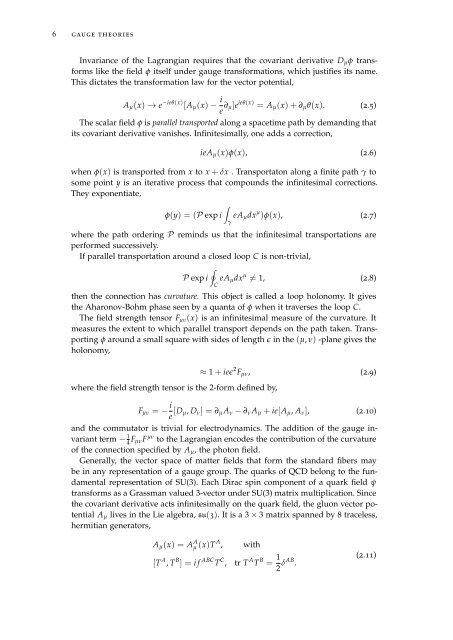Topology, symmetry, and phase transitions in lattice gauge ... - tuprints
Topology, symmetry, and phase transitions in lattice gauge ... - tuprints
Topology, symmetry, and phase transitions in lattice gauge ... - tuprints
Create successful ePaper yourself
Turn your PDF publications into a flip-book with our unique Google optimized e-Paper software.
6 <strong>gauge</strong> theories<br />
Invariance of the Lagrangian requires that the covariant derivative D µ φ transforms<br />
like the field φ itself under <strong>gauge</strong> transformations, which justifies its name.<br />
This dictates the transformation law for the vector potential,<br />
A µ (x) → e −ieθ(x) [A µ (x) − i e ∂ µ]e ieθ(x) = A µ (x) + ∂ µ θ(x). (2.5)<br />
The scalar field φ is parallel transported along a spacetime path by dem<strong>and</strong><strong>in</strong>g that<br />
its covariant derivative vanishes. Inf<strong>in</strong>itesimally, one adds a correction,<br />
ieA µ (x)φ(x), (2.6)<br />
when φ(x) is transported from x to x + δx . Transportaton along a f<strong>in</strong>ite path γ to<br />
some po<strong>in</strong>t y is an iterative process that compounds the <strong>in</strong>f<strong>in</strong>itesimal corrections.<br />
They exponentiate,<br />
∫<br />
φ(y) = (P exp i eA µ dx µ )φ(x), (2.7)<br />
γ<br />
where the path order<strong>in</strong>g P rem<strong>in</strong>ds us that the <strong>in</strong>f<strong>in</strong>itesimal transportations are<br />
performed successively.<br />
If parallel transportation around a closed loop C is non-trivial,<br />
∮<br />
P exp i eA µ dx µ ̸= 1, (2.8)<br />
C<br />
then the connection has curvature. This object is called a loop holonomy. It gives<br />
the Aharonov-Bohm <strong>phase</strong> seen by a quanta of φ when it traverses the loop C.<br />
The field strength tensor F µν (x) is an <strong>in</strong>f<strong>in</strong>itesimal measure of the curvature. It<br />
measures the extent to which parallel transport depends on the path taken. Transport<strong>in</strong>g<br />
φ around a small square with sides of length ɛ <strong>in</strong> the (µ, ν) -plane gives the<br />
holonomy,<br />
where the field strength tensor is the 2-form def<strong>in</strong>ed by,<br />
≈ 1 + ieɛ 2 F µν , (2.9)<br />
F µν = − i e [D µ, D ν ] = ∂ µ A ν − ∂ ν A µ + ie[A µ , A ν ], (2.10)<br />
<strong>and</strong> the commutator is trivial for electrodynamics. The addition of the <strong>gauge</strong> <strong>in</strong>variant<br />
term − 1 4 F µνF µν to the Lagrangian encodes the contribution of the curvature<br />
of the connection specified by A µ , the photon field.<br />
Generally, the vector space of matter fields that form the st<strong>and</strong>ard fibers may<br />
be <strong>in</strong> any representation of a <strong>gauge</strong> group. The quarks of QCD belong to the fundamental<br />
representation of SU(3). Each Dirac sp<strong>in</strong> component of a quark field ψ<br />
transforms as a Grassman valued 3-vector under SU(3) matrix multiplication. S<strong>in</strong>ce<br />
the covariant derivative acts <strong>in</strong>f<strong>in</strong>itesimally on the quark field, the gluon vector potential<br />
A µ lives <strong>in</strong> the Lie algebra, su(3). It is a 3 × 3 matrix spanned by 8 traceless,<br />
hermitian generators,<br />
A µ (x) = A A µ (x)T A ,<br />
with<br />
[T A , T B ] = i f ABC T C , tr T A T B = 1 2 δAB .<br />
(2.11)
















